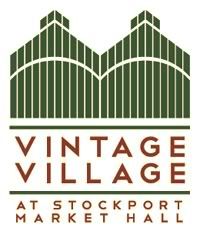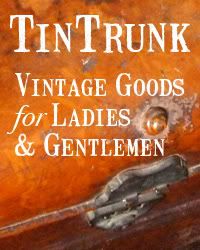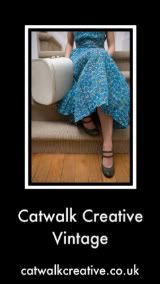Another article I wrote, for a magazine I forget the title of. That no one read.
This is a story about my encounter with a true eccentric when I was about nine, and is accurate in every respect (at least, accurate to my vivid memories of it, which are so strange it almost feels like I dreamt it):
Mr Parkinson
Saturday 31 October 2009
Confessions of a charity shop worker
This was an article I wrote for the Liverpool magazine Plastic Rhino some time ago. It might be a lazy way to fill out this new blog, but what the heck. I need to get a few posts in, and this piece explains a lot about me and my interest in old things:
Confessions of a charity shop worker
Charity shops saved my life. No really they did. From the ‘thrift shops’ on the various RAF camps where I lived as a child, to my student days and beyond, I would have struggled to clothe myself, equip and furnish my numerous shabby bedsits, read as much esoteric and trashy literature or listen to as much esoteric and trashy music without them. Charity shops fed my obsessions with an unpredictable supply of lucky finds, nurtured me as a collector and provided a smugly satisfying contrary form of elitism. All through the eighties, I sneered at the designer label obsessed masses, and never missed an opportunity to crow about how little my new acquisitions cost me. As unpleasant as this perverse snobbery sounds, I’m reluctant to condemn my younger, smart arse self, since I was making a virtue of a necessity. Like a lot of people at that time, I was permanently skint.
Confessions of a charity shop worker
Charity shops saved my life. No really they did. From the ‘thrift shops’ on the various RAF camps where I lived as a child, to my student days and beyond, I would have struggled to clothe myself, equip and furnish my numerous shabby bedsits, read as much esoteric and trashy literature or listen to as much esoteric and trashy music without them. Charity shops fed my obsessions with an unpredictable supply of lucky finds, nurtured me as a collector and provided a smugly satisfying contrary form of elitism. All through the eighties, I sneered at the designer label obsessed masses, and never missed an opportunity to crow about how little my new acquisitions cost me. As unpleasant as this perverse snobbery sounds, I’m reluctant to condemn my younger, smart arse self, since I was making a virtue of a necessity. Like a lot of people at that time, I was permanently skint.
Labels:
article,
charity shops,
conflict,
experience,
magazine,
memory,
old,
vintage,
work
My first vintage dress
Our family wasn't that well off when I was growing up, so we bought and used a lot of what was then called 'second hand' stuff. We lived on RAF camps, which had 'thrift shops' (a curiously trans-Atlantic term which might have been unique to the armed forces, or even just the RAF, I'm not sure).
So I was accustomed to browsing round these thrift shops, second-hand stores and dusty house clearance businesses - I can't remember there being that many charity shops in the 1970s - with my mother from an early age.
I remember distinctly my first 'vintage' dress purchase. It was from a shop in Ipswich, Suffolk, the nearest big town to our RAF camp of the time, and it cost me 50p. I was probably about eight or nine.
Midnight blue silk satin, high neck gathered with two rows of cord elastic forming a little ruffle around the neck, long loosely cut sleeves similarly gathered at the wrist and alternating panels of the satin and its 'wrong' matt side making up the flared skirt, which was approximately knee length (if you were of adult height).
It was a beautiful dress and I had it a long time, although I don't remember ever wearing it but just enjoying it for its luxurious satin cloth and impossibly neat construction.
Much later on I identified it as a 1930s evening dress, but its short length was completely inappropriate for the time. Evening gowns in the 30s were always full length. Eventually I realised that it must have been shortened during the Second World War to conform to contemporary fashion, possibly for use as a dance dress, in the days when people were forced to raid their wardrobes for older clothes and adapt them because they couldn't afford the ration coupons to buy new gear. You couldn't possibly do the jitterbug in a floor length gown!
Some might think it had been ruined by having its skirt brutally chopped off and its careful proportions ruined, but this clear evidence of customisation made it all the more interesting to me, rather than less. This dress told a story, and was the start of my fascination with material culture, although I didn't know that term at the time. That is, how people use and adapt products and their attitudes and feelings about them, rather than focusing on the producer/designer. Consumption as a focus, rather than production.
Most popular history books about fashion and design are completely directed towards the designer and his or her career and notable achievements. Whilst material culture is well established as a field of research in academia, it has yet to make that leap to popular publishing because most readers prefer the hagiographies of elite designers that have set the template for conventional fashion/design histories.
Some museums even to this day would not be interested in a garment that had been substantially altered and would prefer something that was as near to new as possible (in other words, in the form that it was originally intended to be), disregarding the life and history, and changes, that its users/wearers might have needed to impose on it in order to continue wearing it. So in most cases, they are only interested in items that bear no trace of use and aren't interested in the consumer, only the producer. The consumer is effectively erased and ignored. But for me, that's when it starts to get interesting.
I wish I still had that dress!
So I was accustomed to browsing round these thrift shops, second-hand stores and dusty house clearance businesses - I can't remember there being that many charity shops in the 1970s - with my mother from an early age.
I remember distinctly my first 'vintage' dress purchase. It was from a shop in Ipswich, Suffolk, the nearest big town to our RAF camp of the time, and it cost me 50p. I was probably about eight or nine.
Midnight blue silk satin, high neck gathered with two rows of cord elastic forming a little ruffle around the neck, long loosely cut sleeves similarly gathered at the wrist and alternating panels of the satin and its 'wrong' matt side making up the flared skirt, which was approximately knee length (if you were of adult height).
It was a beautiful dress and I had it a long time, although I don't remember ever wearing it but just enjoying it for its luxurious satin cloth and impossibly neat construction.
Much later on I identified it as a 1930s evening dress, but its short length was completely inappropriate for the time. Evening gowns in the 30s were always full length. Eventually I realised that it must have been shortened during the Second World War to conform to contemporary fashion, possibly for use as a dance dress, in the days when people were forced to raid their wardrobes for older clothes and adapt them because they couldn't afford the ration coupons to buy new gear. You couldn't possibly do the jitterbug in a floor length gown!
Some might think it had been ruined by having its skirt brutally chopped off and its careful proportions ruined, but this clear evidence of customisation made it all the more interesting to me, rather than less. This dress told a story, and was the start of my fascination with material culture, although I didn't know that term at the time. That is, how people use and adapt products and their attitudes and feelings about them, rather than focusing on the producer/designer. Consumption as a focus, rather than production.
Most popular history books about fashion and design are completely directed towards the designer and his or her career and notable achievements. Whilst material culture is well established as a field of research in academia, it has yet to make that leap to popular publishing because most readers prefer the hagiographies of elite designers that have set the template for conventional fashion/design histories.
Some museums even to this day would not be interested in a garment that had been substantially altered and would prefer something that was as near to new as possible (in other words, in the form that it was originally intended to be), disregarding the life and history, and changes, that its users/wearers might have needed to impose on it in order to continue wearing it. So in most cases, they are only interested in items that bear no trace of use and aren't interested in the consumer, only the producer. The consumer is effectively erased and ignored. But for me, that's when it starts to get interesting.
I wish I still had that dress!
What is vintage?
I have a bit of a problem with the word. Not that long ago, people might have applied it to wines or cars or perhaps a fondly remembered year of some moment. It suggested prestige and worth, and not a little (implied) snobbery.
Nowadays, vintage is a marketing term applied to anything over approximately five years old, and especially clothing. What was once called 'secondhand' and was the resort of the seriously cash-strapped who couldn't afford anything better (meaning shiny and new) is now dubbed 'vintage' and gains a gloss of desirability and glamour.
Its too late now to rein it in - I use it liberally myself for selling purposes but always with a twinge of conscience, aware that I'm being a teensy bit cowardly and dishonest by employing a term that still seems to me to deserve better somehow.
The plain fact is that no-one is going to buy a 'second-hand Marks & Spencer blouse' or even an 'old Marks & Spencer blouse' (with its unpleasant connotations of decrepitude and decay) but they might seriously consider a 'vintage Marks & Spencer blouse.'
Nowadays, vintage is a marketing term applied to anything over approximately five years old, and especially clothing. What was once called 'secondhand' and was the resort of the seriously cash-strapped who couldn't afford anything better (meaning shiny and new) is now dubbed 'vintage' and gains a gloss of desirability and glamour.
Its too late now to rein it in - I use it liberally myself for selling purposes but always with a twinge of conscience, aware that I'm being a teensy bit cowardly and dishonest by employing a term that still seems to me to deserve better somehow.
The plain fact is that no-one is going to buy a 'second-hand Marks & Spencer blouse' or even an 'old Marks & Spencer blouse' (with its unpleasant connotations of decrepitude and decay) but they might seriously consider a 'vintage Marks & Spencer blouse.'
Labels:
language,
marketing,
selling,
terminology,
vintage
Wednesday 28 October 2009
A longer 'about me'
For as long as I can remember I've been interested in history.
I started collecting at an early age too - one of my first collections was coins, and it felt miraculous that I could possess and hold a Roman coin that had been held by Roman hands perhaps a thousand years ago. It was a physical connection to a long gone past, and, while I'm a deeply sceptical person, there is something weirdly magical about this - as if you could still sense some trace of the energy and humanity of those who originally used that coin.
Objects from the past offer an immediate and vivid kind of time-travelling opportunity that you cannot obtain from books or television programmes. Its all very well to read about how they used to heat solid metal irons against a fire, test the temperature with a quick spit on the plate before skilfully pressing their clothes without scorching them. Its quite another thing to actually pick an old iron up and understand in a physical way what that might have involved - a hot iron, and a pile of wrinkled laundry even more so!
Clothing is perhaps the most evocative of all, since it covered the body, was stretched and shaped by the body, and sometimes retains the form of the wearer. It is the most intimate and personal of objects, and this explains some people's aversion to old clothing, as if it were haunted by spirits. The designer Barbara Hulanicki said recently: "As you get older you get more psychic. I can't stand vintage clothes - there's something so intense about their energy even after they've been cleaned."
This aspect never put me off, in fact quite the contrary. It is a big part of their appeal for me.
You can read about my very first vintage dress purchase here.
I've continued collecting all kinds of old things, in a very scattergun and undisciplined fashion, ever since, guided only by my endless curiosity and continuing delight in finding bargains that relatively few other people seemed interested in at the time. There's an account of my peak collecting years here.
At the same time I gathered quite a substantial personal library of books that helped me understand and contextualise what I was accumulating. In my amateur way, I was teaching myself history through a combination of reading and collecting.
An important figure in this collecting mania was my mother, who wore vintage (then known by the much less glamorous term 'second-hand') clothing from the early 1970s on, and eventually started her own vintage clothing business in the late 1980s by literally emptying her wardrobe. We shared an enthusiasm, and often went browsing together. Her shop in Lincoln, 20th Century Frocks, is still fondly remembered by many customers.
The last link above explains how I renounced collecting, sold up everything except what I could fit into a small van, and moved down south to become a mature student at the University of Brighton. I completed a BA in design history, and enjoyed that so much I stayed to complete an MA in the same subject.
What enchanted me most about these courses is that there was an emphasis on the object as a credible source of evidence, and not just archival texts and pictures. I didn't know about it before, but it was called 'material culture' and my experience in collecting - familiarising myself over the years with the look, feel and construction of objects - was a valuable asset in that field.
So I find myself with a foot in two camps - the rigour and nit-picking precision (and often tiresomely obtuse theory) of academia, and the more pragmatic and commercial world of the vintage trade. And I've never lost that sense of magic in encountering the past through things.
I started collecting at an early age too - one of my first collections was coins, and it felt miraculous that I could possess and hold a Roman coin that had been held by Roman hands perhaps a thousand years ago. It was a physical connection to a long gone past, and, while I'm a deeply sceptical person, there is something weirdly magical about this - as if you could still sense some trace of the energy and humanity of those who originally used that coin.
Objects from the past offer an immediate and vivid kind of time-travelling opportunity that you cannot obtain from books or television programmes. Its all very well to read about how they used to heat solid metal irons against a fire, test the temperature with a quick spit on the plate before skilfully pressing their clothes without scorching them. Its quite another thing to actually pick an old iron up and understand in a physical way what that might have involved - a hot iron, and a pile of wrinkled laundry even more so!
Clothing is perhaps the most evocative of all, since it covered the body, was stretched and shaped by the body, and sometimes retains the form of the wearer. It is the most intimate and personal of objects, and this explains some people's aversion to old clothing, as if it were haunted by spirits. The designer Barbara Hulanicki said recently: "As you get older you get more psychic. I can't stand vintage clothes - there's something so intense about their energy even after they've been cleaned."
This aspect never put me off, in fact quite the contrary. It is a big part of their appeal for me.
You can read about my very first vintage dress purchase here.
I've continued collecting all kinds of old things, in a very scattergun and undisciplined fashion, ever since, guided only by my endless curiosity and continuing delight in finding bargains that relatively few other people seemed interested in at the time. There's an account of my peak collecting years here.
At the same time I gathered quite a substantial personal library of books that helped me understand and contextualise what I was accumulating. In my amateur way, I was teaching myself history through a combination of reading and collecting.
An important figure in this collecting mania was my mother, who wore vintage (then known by the much less glamorous term 'second-hand') clothing from the early 1970s on, and eventually started her own vintage clothing business in the late 1980s by literally emptying her wardrobe. We shared an enthusiasm, and often went browsing together. Her shop in Lincoln, 20th Century Frocks, is still fondly remembered by many customers.
The last link above explains how I renounced collecting, sold up everything except what I could fit into a small van, and moved down south to become a mature student at the University of Brighton. I completed a BA in design history, and enjoyed that so much I stayed to complete an MA in the same subject.
What enchanted me most about these courses is that there was an emphasis on the object as a credible source of evidence, and not just archival texts and pictures. I didn't know about it before, but it was called 'material culture' and my experience in collecting - familiarising myself over the years with the look, feel and construction of objects - was a valuable asset in that field.
So I find myself with a foot in two camps - the rigour and nit-picking precision (and often tiresomely obtuse theory) of academia, and the more pragmatic and commercial world of the vintage trade. And I've never lost that sense of magic in encountering the past through things.
Subscribe to:
Posts (Atom)







